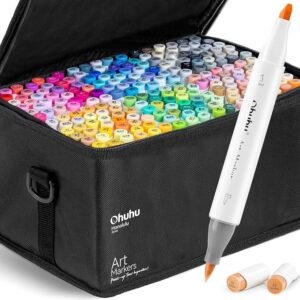Introduction
This comprehensive guide will help you get the most out of your Winsor & Newton markers and paints. By following these detailed steps, you will be able to create stunning artworks with confidence and skill.
Select Tools
Choose from the high-quality Winsor & Newton range:
- Markers: Promarker, Brushmarker.
- Paints: Watercolors, oil paints, acrylics.
Prepare the Surface
Ensure your surface is appropriate for your medium:
- Paper: Use marker paper for markers, watercolor paper for watercolors.
- Canvas: Primed canvas for acrylics or oil paints.
Step-by-Step Process
- Sketch Lightly
- Use a light pencil to outline your drawing. This will serve as a guide for your colors.
- Base Colors
- Apply the base colors with even strokes to ensure smooth coverage. Use light, consistent pressure.
- Layering
- Build up the intensity of colors by adding multiple layers. Allow each layer to dry before adding the next.
- Blend
- Use blending tools or a wet brush to blend colors seamlessly. For markers, you can use a colorless blender.
- Details
- Add fine touches and intricate details with a fine-tip marker or a small brush.
- Finish
- Make final adjustments, ensuring all elements are cohesive and balanced.
Types of Markers and Paints
| Type | Variants | Characteristics |
|---|---|---|
| Markers | Promarker, Brushmarker | Vibrant, blendable, versatile |
| Paints | Watercolors, Oil Paints, Acrylics | Various textures, blendability |
Guide for Proper Use and Care
- Storage: Keep your markers and paints in a dry, cool place to maintain their quality.
- Cap Markers: Always cap your markers to prevent them from drying out.
- Sharpen Pencils: Use quality sharpeners to maintain a fine point on your pencils.
Repairing Markers or Paints
- Markers: If a marker dries out, add a few drops of alcohol to revive it.
- Paints: Add a suitable medium or water to rehydrate dried paints.
Using on Non-Professional Paper
- Heavier Paper: Use heavier paper to prevent bleeding and warping.
- Test First: Always test on a small area to ensure compatibility.
- Light Layers: Apply light layers to avoid oversaturation and buckling of the paper.
Making a Homemade Paint Set
- Materials: Gather containers, pigments, and binders.
- Assembly: Mix the pigments with the binder and fill the containers.
Using Correctly
- Instructions: Follow the manufacturer’s guidelines for the best results.
- Experiment: Don’t be afraid to test different techniques and approaches.
- Practice: Regular practice will improve your skills and confidence.
Solving Dry Marker Issues
- Revive: Add alcohol to revive dry markers.
- Storage: Store markers properly to extend their lifespan.
Disassembling Markers or Paints
- Cap Off: Carefully remove the cap.
- Disassemble: Twist or pull the marker apart.
- Remove Nib: If replaceable, carefully remove the nib.
- Reassemble: Clean or replace parts and reassemble.
Storing Markers or Paints
- Horizontal Storage: Store markers flat to prevent ink from pooling.
- Cool, Dry Place: Keep away from direct sunlight and extreme temperatures.
- Organize: Use storage cases or organizers to keep your tools in order.
By following this step-by-step guide, you will be able to master the use of Winsor & Newton markers and paints, ensuring your artistic projects are completed with professional results.












